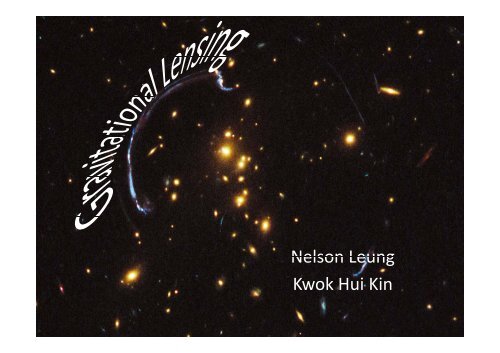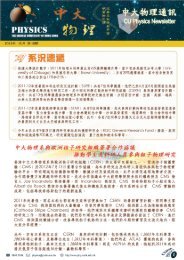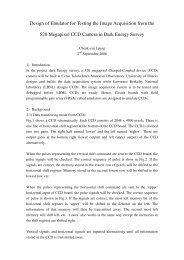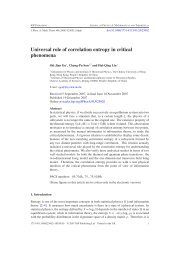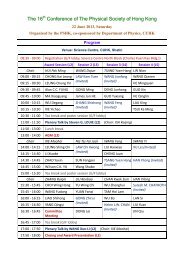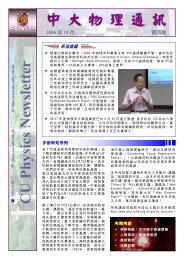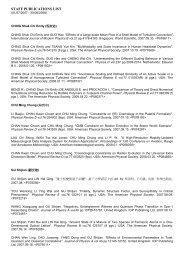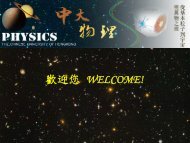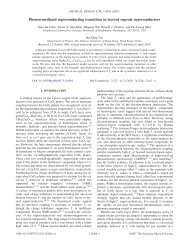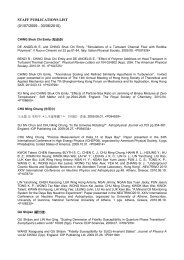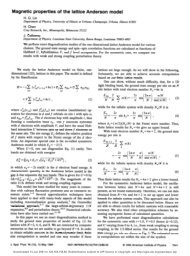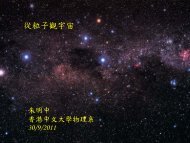Gravitational Lensing
Gravitational Lensing
Gravitational Lensing
You also want an ePaper? Increase the reach of your titles
YUMPU automatically turns print PDFs into web optimized ePapers that Google loves.
Nelson Leung<br />
Kwok Hui Kin
Some History<br />
• In 1916, Albert Einstein’s General Relativity<br />
was published predicting light would be<br />
bend by gravity gravity.<br />
• Einstein himself thought that this<br />
iinformation f ti would ld bbe useless.<br />
l
• In 1919, 1919 this effect was confirmed<br />
by observation.<br />
• Einstein’s Einstein s General Relativity was<br />
correct again in its prediction.<br />
• But Einstein was wrong g in saying y g<br />
<strong>Gravitational</strong> <strong>Lensing</strong> is useless.<br />
• In this century since the first<br />
observational confirmation of<br />
<strong>Gravitational</strong> <strong>Lensing</strong>, it has<br />
became one of the most<br />
important astrophysical tool.
1. Deflection Angle<br />
↳ Deflection angle in Newtonian Mechanics<br />
↳ Review of General Relativity<br />
22. Introduction to <strong>Gravitational</strong> <strong>Lensing</strong><br />
↳ Basic Theory<br />
‐ Lens Equation<br />
‐ Einstein’s Ring<br />
↳ Types of <strong>Lensing</strong><br />
‐ Strong <strong>Lensing</strong><br />
‐ Weak <strong>Lensing</strong><br />
‐ Microlensing<br />
3. Applications of <strong>Gravitational</strong> <strong>Lensing</strong><br />
↳ Observation of quasars<br />
↳ Discovery of Exoplanets<br />
‐ Caustic Crossing<br />
↳ Mass Profiles of Clusters<br />
‐ Reconstuction of mass distribution<br />
‐ Evidence of Dark Matter<br />
Outline
Deflection angle<br />
Introduction to <strong>Gravitational</strong> <strong>Lensing</strong><br />
Applications<br />
Derive deflection angle by Newtonian mechanics<br />
By Hyperbolic orbital equation,<br />
When r = infinte, then cos(θ∞)= ‐1/ε,<br />
We can obtain the deflection angle by putting<br />
Energy of photon E=mc2 gy p /2, / , and momentum l = mc, , and θ∞= ∞ 90°-α<br />
This equation is analogous to<br />
the one derived from the<br />
General Relativity by a factor<br />
of 2!!
Deflection angle<br />
Introduction to <strong>Gravitational</strong> <strong>Lensing</strong><br />
Review of GR<br />
Applications<br />
• Space‐time curved by mass<br />
• Light travels the shortest distance
D LS<br />
D L<br />
Deflection angle Introduction to <strong>Gravitational</strong> <strong>Lensing</strong><br />
Applications<br />
The General Lens equation<br />
Adopted from : ‘<strong>Gravitational</strong> Lenses’, P.Schneider, J,Ehlers,E.E.Falco.<br />
ξ<br />
S L<br />
From Einstein’s deflection law,<br />
From geometry<br />
• Distance measured by redshift<br />
and the Hubble’s Law<br />
(1)<br />
(2)<br />
(3)<br />
(4)
Deflection angle Introduction to <strong>Gravitational</strong> <strong>Lensing</strong><br />
Applications<br />
Multiple images from the same source<br />
Solve eq(4) for θ, we get<br />
θ ‐< < θ θE and θ +> > θ θE In 2D plane, we can observed 2 images<br />
from the same source, source one is inside and<br />
the other one is outside the Einstein ring.
Einstein Ring Applications<br />
Deflection angle Introduction to <strong>Gravitational</strong> <strong>Lensing</strong><br />
g<br />
When the source, lens and observer are collinear, i.e. β(θ) = 0,<br />
• Ring‐like image with angular radius θ E can be observed.<br />
Object name: SDSS J162746.44‐005357.5
Deflection angle Introduction to <strong>Gravitational</strong> <strong>Lensing</strong><br />
Types of <strong>Lensing</strong><br />
Applications
Types of <strong>Lensing</strong> Applications<br />
Deflection angle Introduction to <strong>Gravitational</strong> <strong>Lensing</strong><br />
Lens galaxy<br />
The gravitational lens G2237 + 0305<br />
Adopted from:<br />
http://hubblesite.org/newscenter/archive/releases/1<br />
990/20/image/a/<br />
strong lensing<br />
<strong>Gravitational</strong> <strong>Lensing</strong> in the Galaxy Cluster Abell 2218<br />
NASA / A. Fruchter / STScI<br />
• <strong>Lensing</strong> effect is strong enough to produce<br />
multiple images and giant arcs (red)<br />
• Confirm multiple images from same source by<br />
redshift, size, shape
Deflection angle Introduction to <strong>Gravitational</strong> <strong>Lensing</strong><br />
Weak lensing<br />
Applications<br />
• Th The most common type of f<br />
gravitational lensing.<br />
• Line of sight is large.<br />
• The deflection of light is very slight.<br />
• No multiple images but distortion<br />
• No multiple images but distortion,<br />
shearing, rotation and magnification.
Deflection angle Introduction to <strong>Gravitational</strong> <strong>Lensing</strong><br />
Microlensing<br />
Applications<br />
• The lens mass is too low, mass of a<br />
planet to a star, for the<br />
displacement of light to be<br />
observed easily.<br />
• The apparent brightening of the<br />
source may still ill bbe detected.<br />
d d
Deflection angle Introduction to <strong>Gravitational</strong> <strong>Lensing</strong><br />
Applications<br />
Brightness g magnification g<br />
• Light flux F is the product of<br />
surface brightness g I and solid<br />
angle dw. Since I is contant,<br />
F is proportional to dw<br />
• dw = A/D 2<br />
• A S/D S 2 < AL/D L 2 => Fs
How cosmologists g and<br />
astrophysicists<br />
make use of these effects?
Deflection angle Introduction to <strong>Gravitational</strong> <strong>Lensing</strong> Applications<br />
Nature’s Nature s Telescope<br />
• Able to collect distant light to a point of focus,<br />
act as a telescope. p<br />
All b billi f li h<br />
• Allow us to observe billions of light‐years away<br />
object‐ e.g. Quasars.
Deflection angle Introduction to <strong>Gravitational</strong> <strong>Lensing</strong> Applications<br />
Observation of Quasars<br />
What is Quasar?<br />
• Distant object determined by high redshift<br />
of electromagnetic energy, and hence<br />
appears faint<br />
• Extremely luminous<br />
• First discovered in late 1950s by radio<br />
telescope with no corresponding visible<br />
object<br />
• Until 1979 two quasar images are<br />
observed<br />
observed…
Deflection angle Introduction to <strong>Gravitational</strong> <strong>Lensing</strong> Applications<br />
First Observation of Quasars<br />
0957+561 the first QSO image<br />
Adopted from : D.walsh, et.al. ‘0957+561 A, B: twin quasistellar object or gravitational lens?’,<br />
Nature Vol. 279,1979<br />
• 5.7 arcsecond separation<br />
• 1.405 redshift (87 billion light‐years)<br />
• Apparent magnitude m ~ 17<br />
Th Thanks k tto GL GL, we can now<br />
see the images of quasars!!
Deflection angle Introduction to <strong>Gravitational</strong> <strong>Lensing</strong> Applications<br />
Spectra of observed object A and B.<br />
Adopted from : D.walsh, et.al. ‘0957+561 A, B: twin quasistellar<br />
object or gravitational lens?’, Nature Vol. 279,1979<br />
• Identical relativistic jet, powerful<br />
jets of plasma emerging from<br />
massive objects<br />
• Similar redshift<br />
• Similar Visible light spectrum<br />
• Magnification of images by GL<br />
make it possible to see the images<br />
• Very unlikely to have identical<br />
quasars that close to each other.<br />
Concluding they are multiple<br />
images g from a same quasar q<br />
produced by strong gravitational<br />
lensing.
Deflection angle Introduction to <strong>Gravitational</strong> <strong>Lensing</strong> Applications<br />
Caustic Curve<br />
• Magnification increases when source is approaching<br />
the h caustic i li line (red ( d li line) )<br />
• Microlensing in multiple lens system have caustic<br />
curve, where the magnification is very high.<br />
• When the source is inside the caustic contour, more<br />
image will produce
Deflection angle Introduction to <strong>Gravitational</strong> <strong>Lensing</strong> Applications<br />
Discovery y of Exoplanets p<br />
Light curve of OGLE 2003‐BLG‐235/MOA 2003‐BLG‐53<br />
Adopted from: www.nd.edu/~bennett/<br />
• Microlensing is the only method of<br />
dt detecting ti planets l t in i the th other th galaxies l i<br />
until now<br />
• Without a planet, planet we can only observe hill hill‐<br />
shaped curve due to the star (single‐lens<br />
system)<br />
• A planet p with star pproduces two spikes p on<br />
the curve (two‐lens system)<br />
• Graph analysis shows the existence of<br />
small mass planet
Deflection angle Introduction to <strong>Gravitational</strong> <strong>Lensing</strong> Applications<br />
Adopted from: www.nd.edu/~bennett/<br />
Advantage of this method<br />
• The only y method to find exoplanet p of other<br />
galaxies.<br />
• Does not require planets whose orbits happen<br />
to be perfectly aligned from the astronomers'<br />
vantage point. (Transit Method—If a planet<br />
crosses in front of its parent’s star disk, the<br />
observed brightness of the star drops by a<br />
small amount depending on the relative size of<br />
the planet)<br />
• Relatively short period of observation time, at<br />
most weeks. (Astrometry ‐ detecting<br />
extroplanets through observation of the<br />
fluctuation of motion of star due to planets ‐<br />
requires years or even decades)<br />
• Able to find small planets directly
Deflection angle Introduction to <strong>Gravitational</strong> <strong>Lensing</strong> Applications<br />
Mass Profile of Galaxy Clusters<br />
Reconstruction of mass distribution<br />
• Mass mapping by GL is valuable because does not<br />
depend on dynamic state of the cluster/galaxy<br />
(h (the tradition method h for f searching h mass<br />
distribution is by their dynamic state)<br />
• Using strong and Weak <strong>Lensing</strong> to map the mass<br />
distribution of the Lens<br />
• Multiple images of Strong <strong>Lensing</strong> enable us to<br />
construct the lens lens’ mass using the lens equation<br />
with numerical calculations<br />
• Weak Lens’ shearing effect is the other parameter<br />
for mass mapping<br />
• In real situations, parametric models of the<br />
source and the lens are complicated We<br />
construct mass model to match observed images<br />
and find best‐fit parameters<br />
Adopted d dffrom: Annu. Rev. Astron. Astrophys. h 1999. 37: 127‐189<br />
source and the lens are complicated. We
Deflection angle Introduction to <strong>Gravitational</strong> <strong>Lensing</strong> Applications<br />
Mapping of mass using Strong <strong>Lensing</strong><br />
• Recall this equation equation. In 2D case case, if the double images from<br />
a same source is identified, this equation can be solved to<br />
find the lens’ mass.<br />
• In real situation, where there are many different sources<br />
producing multiple images, a mass model is proposed and<br />
fitted to produced the corresponding multiple images.
Deflection angle Introduction to <strong>Gravitational</strong> <strong>Lensing</strong> Applications<br />
Mapping of mass using Weak <strong>Lensing</strong><br />
This is called the Mapped potential of the lens.<br />
pp p<br />
The integral is the three‐dimensional Newtonian gravitational potential of the<br />
lensing object projected on the coordinate along the line of sight<br />
L
Deflection angle Introduction to <strong>Gravitational</strong> <strong>Lensing</strong> Applications<br />
Mass mapping by Shearing effect<br />
shearing<br />
• The orientation of intrinsic ellipticities of galaxies<br />
should be almost entirely random<br />
• Observing shearing of the images images, we can get the<br />
mass distribution<br />
shear convergence<br />
θ = Angular position<br />
Potential mapped on the coordinate of line<br />
of sight g
Deflection angle Introduction to <strong>Gravitational</strong> <strong>Lensing</strong> Applications<br />
Evidence of Dark Matter<br />
Adopted from: J. Tyson, G. Kochanski and I. Dell’Antonio, Ap. J. Lett. 498 107 (1998)<br />
• Combine weak and strong lensing analysis analysis, we can map the mass distribution of<br />
a cluster. Galaxy cluster CL0024+1654 is an example.<br />
• Spikes are due to the visible galaxy<br />
• A smooth background mass density is observed in the region without any<br />
luminous matter
More Applications…<br />
Applications<br />
• Finding Hubble constant<br />
• Black Hole hunting<br />
• ….
Conclusion<br />
In recent years, gravitational lensing has become<br />
more and more important p in astrophysics p y and<br />
cosmology. We hope through our presentation<br />
you could get the basic ideas and understand its<br />
usefulness in studying our universe.
Thank you
References<br />
• D.walsh, et.al. ‘0957+561 A, B: twin quasistellar object or gravitational lens?’, Nature Vol. 279,1979.<br />
• PSchneider P.Schneider, J Ehlers Ehlers, EE E.E. Falco Falco, ‘<strong>Gravitational</strong> <strong>Gravitational</strong> Lenses’ Lenses , Springer Springer, 1999 1999.<br />
• A.Abdo, ‘<strong>Gravitational</strong> <strong>Lensing</strong>’, department of physics and astronomy, Michigan State University.<br />
• Wambsganss, J., ‘<strong>Gravitational</strong> <strong>Lensing</strong> in Astronomy’, Living Rev. Relativity 1, (1998), 12.<br />
• Frittelli Frittelli, SS., Newman Newman, E., E ‘ An Exact <strong>Gravitational</strong> <strong>Lensing</strong> equation equation’ arXiv:gr‐qc/9810017v1 arXiv:gr qc/9810017v1, 5 Oct<br />
1998.<br />
• www.googlescholar.com/<br />
• http://articles.adsabs.harvard.edu/full/1989A%26A...221....1K<br />
• http://www.aanda.org/index.php?option=com_article&access=standard&Itemid=129&url=/articles<br />
/aa/full/2002/30/aah3555/aah3555.right.html<br />
• http://ned.ipac.caltech.edu/level5/Blandford/frames.html<br />
• http://relativity.livingreviews.org/open?pubNo=lrr‐1998‐12&page=articlese1.html


